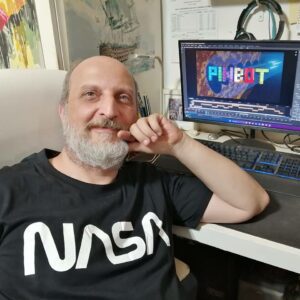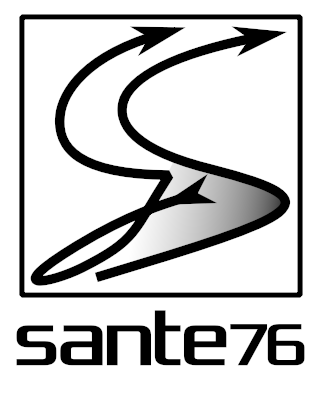Hello, I’m Gianluca Santeramo, but for quite some time now, people have simply known me as Sante. It’s just a shortened version of my surname, and nothing more. It seems that everyone prefers this friendly, abbreviated name—perhaps because my real, full name can be quite a mouthful!
When I was six years old, my parents gave me a special gift: my first personal computer, a Commodore VIC-20. That marked my initial encounter with the world of IT. Admittedly, at that time, I primarily used it for playing games—albeit much simpler ones compared to the sophisticated options available nowadays.
However, my curiosity never waned. I began experimenting with BASIC, the programming language that accompanied those early home computers. While the programs I created were exceptionally basic—far from what one might consider sophisticated algorithms—they marked a humble starting point in my journey.
A few years later, an upgrade arrived, bringing a Commodore 64 into my life, complete with a floppy drive and a printer. Simultaneously, my fascination with games took a new turn—I became intrigued not just by playing them but by understanding how they were made.
For many years, nothing particularly remarkable occurred in a world without the internet. In an era where books on the subject were scarce and not particularly engaging, and with a relatively solitary hobby, computers were far from the ubiquitous and popular devices they are today.
However, in 1991, it was time to attend high school, and fortunately, there was one that focused on computer programming. I spent five years there, achieving quite good results. However, I couldn’t help but feel disappointed—despite my interest in the subject, the curriculum never delved into areas like computer graphics or other aspects closely related to game development.
I earned the title of ‘perito,’ which translates to ‘expert’ in Italian, though the term also carries a somewhat ominous connotation, meaning ‘dead.’ Not my favorite association, to be honest. Despite my title, I learned next to nothing about game programming during my academic journey.

However, school proved proficient in other aspects: I learned how to write algorithms through numerous examples, delved into the mathematics behind data structures, and acquired theoretical knowledge about the grammar of computer languages in general. This type of knowledge is often lacking in the pure hobbyist realm because almost nobody discusses it outside the school environment. So, when I finished school, I wasn’t yet fully equipped to create a game on my own, but I had gained enough knowledge to independently seek and study what I needed.
So, I considered pursuing the university path, but unfortunately, it was simply not possible—money, a simple, frustrating, and damn obstacle. In 1995, finding work as a programmer was a rarity, especially in my city. I ended up becoming a waiter, as the demand for programmers was scarce.
Meanwhile, a new milestone in IT emerged from the universities and reached the common people: Object-Oriented Programming (OOP) started to become widespread, especially through well-known products at the time, such as the Borland programming suites like “Delphi“. I studied it on my own.
At first, I studied it infrequently, relying on books that were only available in English. This is because, even today, I am capable of reading English with a certain ease, but I lack proficiency in writing and speaking it. I read extensively and write to a lesser extent, mainly due to a lack of opportunities for spoken communication in English. It’s not a choice but rather a circumstance.
Another milestone in IT started to become widespread around the same time: the internet. I’m as curious as an ape, and I needed to understand it. So, I bought my first modem—an old, noisy, slow 56kbps. The early internet was quite an annoying place; only computer enthusiasts seemed to enjoy it. I recall there were just a few services, mainly centered around computer programming and this new, strange language called HTML. Eager to comprehend more, I subscribed to an online free service called ‘Xoom’ to try creating my own website, purely for fun.
When I subscribed, that peculiar computer on the other side of my noisy modem asked for some information—my name, surname, birthday. Then, it suggested I choose a username and proposed ‘sante76’. Without much thought, I accepted the suggestion, and thus, my historical nickname on the net was born. So, when you see my logo, it’s not just a trademark; it’s a representation of me. You can think of it more like the logo and name of a rock band rather than something associated with a big industry.
Some years later, I secured a fresh position, this time as a computer programmer! At the outset, it brimmed with excitement, marking a new chapter in my life. However, as time unfolded, this enthusiasm transformed into a different disillusionment: the relentless pace of the industry. The incessant demand for immediate results led to software fraught with bugs, far from being primed for real-world applications, and ultimately, mediocre. This is why I prefer to work independently. This discontent prompted me to explore a different career path. Subsequently, I transitioned to a job unrelated to the computer world, focused solely on financial gains.
In 2007, I started my new job, and I find great satisfaction in it. It’s straightforward, comes with significant responsibilities, and pays enough for me to live comfortably. Moreover, it provides me with a surplus of free time. Whether in the morning or evening, I have plenty of time for myself.
Meanwhile, another significant IT phenomenon emerged: open source software. Numerous new, entirely free programs came into existence. ‘Free’ as in freedom of speech, but also ‘free’ as in free beer. It might not be a profound philosophical idea, but software that’s free to use holds great importance for ordinary people. Even the most skilled programmers can achieve little without it. This is especially true a decade ago (as of my writing in 2023), when proprietary software had exorbitant prices, sometimes equivalent to the cost of a small car. I wasn’t affluent enough to afford them. Open source has granted me the freedom to learn new things and the freedom to discuss them.
My curiosity was once again driving me. I started studying tools like Blender, for example. While I invested a considerable amount of time, I must admit it wasn’t enough to transform me into a proficient 3D video maker; I was merely indulging in it for the enjoyment. Nevertheless, I never abandoned the idea of computer programming. I delved into languages like Java, C#, and C++, having previously encountered C in school, which made these languages seem less complex. The real challenge each time, however, lay in navigating their extensive libraries. What proved truly disheartening was what novelists refer to as the ‘white paper syndrome.’ Each time I struggled to decide what to create with these languages. A database? Not my preference; they irritated me. A game? I felt inadequate. Making a game, especially as a solo endeavor, seemed like an overwhelmingly daunting task.
Much changed after a considerable amount of time. I stumbled upon XNA, a free library from Microsoft designed to simplify game programming. It was a library, not a game engine; at that time, full-fledged game engines were still a bit early in development. Finally, I found a way to create a game on my own. Grasping XNA wasn’t a walk in the park due to the multitude of skills required to assemble something substantial—a good game. It was all about code, with no visual editors to ease the creation process, just lines of code. Numerous challenges surfaced, especially in incorporating external resources such as music and images. However, in the realm of 2D games, I managed to bring “Rock’n’Rocks” to life. There’s still a video about it at this link (I hope). “Rock’n’Rocks” served as a 2D clone of the classic game “Asteroids,” featuring power-ups to alter weapons and introduce various behaviors. Although it may not have been a groundbreaking game, and I recognize its limitations, it marked my first attempt, and I felt a sense of pride in my accomplishment.
I discovered XNA a bit late, in 2011. After a couple of years, Microsoft decided to retire the project. I felt a bit frustrated; about two years of study seemed to go to waste. I still have a couple of books here, on my desk. These books serve as a reminder of a simple fact: the industry does nothing for nothing. If they don’t see any sort of gain, regardless of consequences, they wipe the slate clean. It’s that simple. Back in the dark once again.
Once again, I found myself waiting for Godot, like Samuel Beckett’s says. The surprise came when Godot finally arrived, not as a person but as a beautiful software. I discovered Godot in 2018, starting from its 3.0 version, and it was love at first sight. An open source platform, it came with a plethora of visual helpers, including editors for levels and animations…
For the first time, thanks to its skills and being an open source software, I felt confident enough to try making a game on my own. I was almost certain that Godot would not abandon me in the future, unlike XNA. Before discovering Godot, I had heard about Unity, but I hesitated to study it, still haunted by my experience with XNA. The lingering question was, ‘Are we sure Unity won’t become a paid software in a few years? I need time to study and more time to make a game!’ The answer was uncertain, and I didn’t want to take the risk. Godot, on the other hand, was and is a different story. The simple fact that it is open source means that even if the current developers choose to move on, others can continue working on it. This provides great reassurance. So, I started working with Godot, and ‘Pinbot’ was born… Pinbot is… Pinbot is another story, which you can find here.

